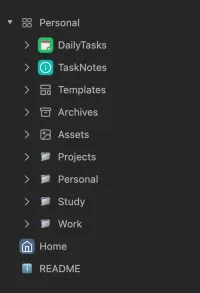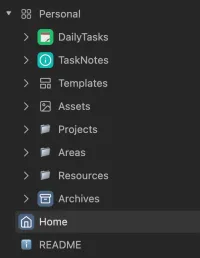In modern society, various digital resources are being produced and used. However, due to advances in search functionality, these resources are often not well organized and can instead be scattered haphazardly or forgotten. Additionally, the increase in storage services has heightened the possibility of resource loss.
In this situation, to help individuals increase their productivity and prevent digital resource loss, let's learn about Tiago Forte's "Building a Second Brain" and the PARA method.
Building a Second Brain
"Building a Second Brain" is a productivity strategy that means building an external system using digital tools to record, organize, and utilize ideas, projects, and information. This helps prevent forgetting information you've heard or learned before and allows easy access when you need it.
This system aims to improve personal creativity and productivity and can be an effective tool for various users including professionals, managers, those in creative jobs, students, etc.
The process of building a second brain usually starts with the following 4 steps called CODE, taking the first letter of each:
- "Capture": Capture new ideas or knowledge in digital or physical form.
- "Organize": Organize captured ideas or knowledge so they can be easily found within the system.
- "Distill": Distinguish and summarize important information, emphasizing its importance and value.
- "Express": Integrate new ideas or knowledge into work, projects, or conversations, utilizing them in the real world.
Therefore, "Building a Second Brain" is a strategy for effectively managing and utilizing information and ideas, allowing both individuals and teams to work more efficiently and think more creatively.
What is the PARA method?
So how should we manage and store the resources generated through the CODE 4 steps? A system for personal task management and information management can use the "PARA" method. PARA is an acronym made from the first letters of Projects, Areas, Resources, and Archives.
The concept of the second brain introduced above is a strategy for managing productivity, and the method for managing data through that strategy is called the PARA method.
PARA consists of the following four categories:
Projects:
- A series of tasks that must be completed to achieve short-term goals.
- Have deadlines.
- Examples: Writing reports, planning events, etc.
Areas:
- Areas or roles in life that require continuous maintenance.
- Have no deadlines.
- Examples: Health, career, hobbies, finances, etc.
Resources:
- Categories that collect information and knowledge about specific topics or interests.
- Examples: Books, articles, lecture notes, etc.
Archives:
- Materials that are not currently active but are stored for future reference.
- Examples: Completed projects, hobbies no longer pursued, previous course materials, etc.
Projects and Areas are easy to distinguish. These two deal with clear topics and are divided by the presence or absence of goals. On the other hand, Resources was personally confusing for me to understand exactly what it was, but it's more versatile knowledge data rather than simple data that could be included in Projects or Areas.
For example, if you study data structures aimlessly without goals, you can create resources about data structures in Resources. If this resource continues to grow later, you can subdivide and separate each item in data structures again. Also, when a Project references information about data structures, you can link notes written in Resources.
Projects, Areas, Resources, and Archives can move between each other depending on circumstances.
Who is the PARA method suitable for?
The advantage of the PARA method is its flexibility and universality. Through this, you can systematically manage various activities from hobby tracking to idea implementation.
Are you still not sure if this method is suitable for you? Here are some examples of when the PARA method is useful:
👨🎓 Students: Students are probably already using various digital tools. Layering PARA on top of these tools helps systematically organize and connect information.
👩💻 Writers: Writers need to manage various ideas and plots. Using PARA allows more systematic management of the creative process.
👨💼 Entrepreneurs: Entrepreneurs need to simultaneously manage various aspects of business. PARA provides a framework for systematically managing these various elements.
🤷♀️ General Public: We all have various goals and aspirations. Systematically managing these goals and tasks through PARA increases the probability of achieving goals.
👨💻 Developers: Developers need to manage various information like code, documentation, issues, etc. Using PARA allows systematic organization and management of various aspects of projects, making the development process more efficient.
⚡️ Productivity Enthusiasts: Looking for new task management and time management strategies? The PARA method is an excellent way to improve personal productivity.
Tools for Using the PARA Method
PARA is just a productivity management technique, so it's not tied to specific tools. If you search, you'll find examples of using the PARA method with various applications like Notion, Obsidian, or other applications.
Since I use Obsidian as my note-taking app, I configured it referring to the article below.
Building Your Second Brain with Obsidian: A Guide Inspired by Tiago Forte
Previous Obsidian Workspace Structure 
Obsidian Workspace Structure Changed to Use PARA Method 
Zettelkasten
The Zettelkasten method creates several related notes by interests, making it like a personal Wikipedia. I think this part aligns with the PARA method, but I think the PARA method is more optimized for modern information management.
For those interested, I'm leaving a link below.
Conclusion
Currently, I'm managing Daily Tasks with the Obsidian Tasks Plugin in addition to this method.
Pomodoro isn't effective for developers because it interrupts deep work, and GTD helps with project achievement but is insufficient for long-term structuring and management. So currently, the most suitable digital content management method for me seems to be the PARA method.
Actually, I haven't been using it for long, so this article introduced the PARA method and simple examples. I'll come back with more detailed content after using it for a few more months and reading Tiago Forte's book.
